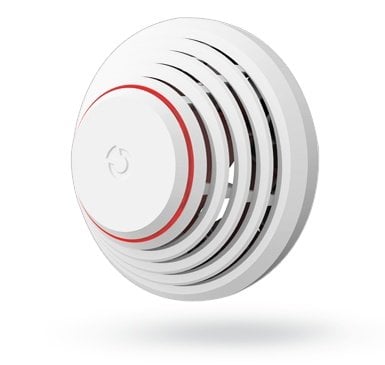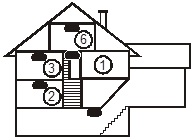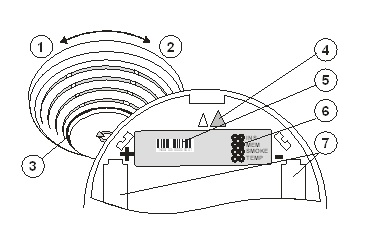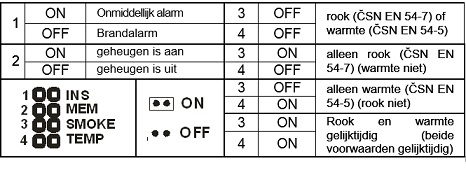Service instructions for JA-150ST Wireless combined smoke/heat detector This product is part of the JABLOTRON JA-100 alarm system. It provides indoor fire hazard detection. It is not intended for installation in an industrial environment. It contains an optical smoke detector and a temperature sensor. The optical smoke detector is very...
JA-150ST
Too much choice? Chat or call us at 085-0160316
There are no products in these categories. Shop on.

Service instructions for JA-150ST
Wireless combined smoke/heat detector
This product is part of the JABLOTRON JA-100 alarm system. It provides indoor fire hazard detection. It is not intended for installation in an industrial environment. It contains an optical smoke detector and a temperature sensor. The optical smoke detector is very sensitive to larger particles, which occur in dense smoke, less sensitive to small particles, which occur in fires of liquids, such as alcohol. Therefore, it also incorporates a temperature sensor, which has a slower response, but is able to detect a fire with a small amount of smoke. The detector responds to the status (it reports activation and also calming of the situation). The product is intended to be installed by a trained technician with a valid Jablotron certificate.
Placing the detector
Smoke enters the detector via flowing air - that is why it must be installed in a place, where the air flows well thanks to natural thermal circulation (usually to the ceiling). The detector can only be used in an enclosed interior. It is not suitable there, where the smoke can spread and cool down (e.g. high ceilings - more than 5 m) - the smoke then does not reach the detector.
In dwellings, the detector should always be installed in the area leading to the exit (escape route) see figure 1. If the floor area in the house exceeds 150 m², another detector must be installed there, in another suitable part of the house, see fig. 2.
1. kitchen,
2. living room,
3. - 6. bedrooms
? / minimum coverage by detectors
? recommended coverage by detectors

Figure 1

Figure 2

Figure 3
Men recommend installing a detector in every room, where people sleep.
Place under horizontal ceilings
If possible, install the detector in the middle of the room. Since a cold layer of air may form near the ceiling, the detectors must not be recessed into the ceiling. The fire detector must never be installed in a corner of the room (observe a distance of min. 0.5 m from the room corner, see figure 4). In corners, the air circulates poorly.
Placing under sloping ceilings
If the ceiling does not have a suitable straight surface (e.g. an attic room), the detector can be placed according to Fig. 5.

Figure 4

Figure 5
The centre of the room, the best place, a possible place
Walls, partitions, obstacles, bare-beam ceilings
The detector must be installed at least 0.5 m from a wall or obstacle. If the room is narrower than 1.2 m, the detector must be installed within the middle third of its width. If the room is divided into sections by furniture, shelving or half partitions, above which there is no more than 0.3 m distance from the ceiling, the individual sections should be considered separate rooms. In all directions below and around the detector, a clearance of min. 0.5 m must be left. Any irregularity of the ceiling (such as a support beam), with dimensions greater than 5 % of the ceiling height, are considered walls where all the above remains in force.
Ventilation and air movement
Detectors must not be installed directly at the outlet of ventilation, air conditioning and the like. If the air is introduced through a perforated ceiling, the ceiling must not be perforated 0.6 m in all directions around the detector.
Detector must not be placed:
- There, where the air flows poorly (niches, corners, ridges of ceilings at A-roofs and the like.)
- There, where it is dusty, smoky or steamy
- In places, where air flows intensively (close to fans, heat sources, mouths of ventilation, draught holes and the like.)
- in kitchens and humid rooms (steam, smoke and oily vapour may cause false alarms or detection failure)
- next to fluorescent or energy-saving lamps (electrical interference may trigger a false alarm)
- in places with large quantities of small insects
Please note: Most often, the detector becomes unwanted active due to an incorrect installation location.
More detailed instructions for installation can be found in TS 54-14 and 34 2710.
Installation
When installing, follow the advice given in the previous paragraphs.

Figure 6: 1 - detaching (removing) the detector; 2 - attaching (setting up) the detector; 3 - optical indication of status; 4 - orientation arrow for setting up; 5 - serial number; 6 - configuration junctions; 7 - battery insertion location
1. Open the detector screen by turning it to the left (1).
2. Screw the plastic back panel to the selected position.
3. Adjust the configuration junctions (6) according to the table below
4. Continue to follow the installation instructions for the central unit. Basic steps:
a. In the F-Link programme, select the desired position on the Peripherals card and start the learning mode with the Add key.
b. Inserting the last battery into the detector sends the learning code to the system - as confirmation of sending, the signal light (3) flashes briefly.
5. Place the detector on the plastic back panel. It can only be in one position, indicated by arrows (4) on both plastic parts. Turning the detector to the right (2) locks it in place.
Note:
The detector can also learn in the system by entering the serial number (5) via the F-Link programme or via the keypad (or barcode reader). All digits below the barcode must be entered (1400-00-0000-0001).
Set up the detector
In the F-Link programme on the peripherals card and using the jumpers in the detector, the properties of the detector can be set up.

1 ON Immediate alarm 3 OFF smoke (EN 54-7) or heat (EN 54-5)
OFF Fire alarm 4 OFF
2 ON memory is on 3 ON only smoke (EN 54-7) (heat not)
OFF memory is off 4 OFF
3 OFF only heat (EN 54-5) (smoke not)
4 ON
3 ON Smoke and heat simultaneously (both conditions simultaneously)
4 ON
Through link 1 INS chooses whether the detector, upon activation to the central station, the fire alarm or immediate alarm (is used, when in ordinary situation smoke may occur - fireplace, cigarettes and the like.). It applies at reaction set on the central controller Fire or Immediate. If a reaction other than Basic reaction is set by the F Link programme, the control unit will react depending on the setting via Reaction in the peripheral devices map.
Connection 2 MEM Signalling of alarm memory - if switched on, optical signalling on the detector remains active for 30 minutes after termination of alarm status.
Junction 3 and 4 SMOKE and TEMP Combination of these junctions determines whether the detector will react to smoke, heat, ....
Fire alarm
Optical detector: After smoke enters the detector, alarm is switched on, the red signal light starts flashing rapidly (approx. 8x per second). The indication remains on until the room is ventilated (and thus also the detector's detection chamber).
Temperature sensor: As soon as the temperature exceeds the limit set in the detector, alarm is switched on, the red signal light flashes rapidly (approx 8x per second). The indication remains on until the temperature drops e.g. by ventilating the room.
Memory of alarm: When the indication of alarm memory is on, the signal light continues to indicate the activation of the detector by flashing for 30 minutes after the end of alarm status. The indication can be stopped by activation of the tamper sensor by briefly removing (twisting) the detector.
Sabotage alarm: When the detector is removed, it sends a sabotage signal.
Detector testing and maintenance
Functioning of the detector can be checked by a test spray. The test should be carried out once every 30 days. The detector should be regularly cleared of dust, cobwebs, etc., no other maintenance is required.
Please note: Never test the detector by lighting an open fire in the object.
Replace batteries in the detector
The system automatically reports as soon as the batteries are running low. A weak battery is also indicated by a flash every 30 sec. Before replacing the batteries in the detector, the system must be switched to Service mode (otherwise sabotage alarms will be called). It is necessary to always replace all three batteries at the same time and use the same type from the same manufacturer. After the batteries are inserted, an autotest automatically starts, checking the voltage of the batteries, the state of the detector and this information is sent to the central controller.
Indication of malfunction
The detector checks its own operation. As soon as a fault is detected, the indicator light keeps flashing rapidly for 1 minute and then three short flashes every 30 sec every time. In this case, take out the batteries for 1 minute and put them back in. If the light starts flashing permanently again after about 1 minute, take the detector to service.
Technical parameters
Power supply 3 pcs. alkaline batteries AA 1.5 V, 2.4 Ah)
Typical battery life approx. 2 years
Communication band 868.1 MHz, protocol Jablotron
Communication range approx. 300 m (free terrain)
Dimensions diameter 126 mm, height 50 mm
Weight 150 g
smoke detection optical dispersion of light
sensitivity smoke detector m = 0.11 ¸ 0.13 dB/m cf. CSN EN 54-7
temperature detection class A2 cf. CSN EN 54-5
alarm temperature +60°C to +70°C
range operating temperatures -10°C to +80°C
Complies with CSN EN 54-5, CSN EN 54-7, CSN EN 54-25
Further complies with CSN ETSI EN 300220, CSN EN 50130-4,
CSN EN 55022, CSN EN 60950-1
Conditions of operation CTÚ VO-R/10/09.2010-11
Complies with requirements regulation no. 23/2008Sb. on fire protection of buildings
1293-CPD-0249
This product has been designed and manufactured in accordance with the provisions to be applied to it: Government Decree No 190/2002 Sb., 426/2000 Sb., in force, if used according to its intended use.
Note: Although this product does not contain harmful materials, do not dispose of it in the domestic waste, but dispose of it at the collection point designated for electronic waste.
Placing the detector
Smoke enters the detector via flowing air - that is why it must be installed in a place, where the air flows well thanks to natural thermal circulation (usually to the ceiling). The detector can only be used in an enclosed interior. It is not suitable there, where the smoke can spread and cool down (e.g. high ceilings - more than 5 m) - the smoke then does not reach the detector.
In dwellings, the detector should always be installed in the area leading to the exit (escape route) see figure 1. If the floor area in the house exceeds 150 m², another detector must be installed there, in another suitable part of the house, see fig. 2.
1. kitchen,
2. living room,
3. - 6. bedrooms
? / minimum coverage by detectors
? recommended coverage by detectors

Figure 1

Figure 2

Figure 3
Men recommend installing a detector in every room, where people sleep.
Place under horizontal ceilings
If possible, install the detector in the middle of the room. Since a cold layer of air may form near the ceiling, the detectors must not be recessed into the ceiling. The fire detector must never be installed in a corner of the room (observe a distance of min. 0.5 m from the room corner, see figure 4). In corners, the air circulates poorly.
Placing under sloping ceilings
If the ceiling does not have a suitable straight surface (e.g. an attic room), the detector can be placed according to Fig. 5.

Figure 4

Figure 5
The centre of the room, the best place, a possible place
Walls, partitions, obstacles, bare-beam ceilings
The detector must be installed at least 0.5 m from a wall or obstacle. If the room is narrower than 1.2 m, the detector must be installed within the middle third of its width. If the room is divided into sections by furniture, shelving or half partitions, above which there is no more than 0.3 m distance from the ceiling, the individual sections should be considered separate rooms. In all directions below and around the detector, a clearance of min. 0.5 m must be left. Any irregularity of the ceiling (such as a support beam), with dimensions greater than 5 % of the ceiling height, are considered walls where all the above remains in force.
Ventilation and air movement
Detectors must not be installed directly at the outlet of ventilation, air conditioning and the like. If the air is introduced through a perforated ceiling, the ceiling must not be perforated 0.6 m in all directions around the detector.
Detector must not be placed:
- There, where the air flows poorly (niches, corners, ridges of ceilings at A-roofs and the like.)
- There, where it is dusty, smoky or steamy
- In places, where air flows intensively (close to fans, heat sources, mouths of ventilation, draught holes and the like.)
- in kitchens and humid rooms (steam, smoke and oily vapour may cause false alarms or detection failure)
- next to fluorescent or energy-saving lamps (electrical interference may trigger a false alarm)
- in places with large quantities of small insects
Please note: Most often, the detector becomes unwanted active due to an incorrect installation location.
More detailed instructions for installation can be found in TS 54-14 and 34 2710.
Installation
When installing, follow the advice given in the previous paragraphs.

Figure 6: 1 - detaching (removing) the detector; 2 - attaching (setting up) the detector; 3 - optical indication of status; 4 - orientation arrow for setting up; 5 - serial number; 6 - configuration junctions; 7 - battery insertion location
1. Open the detector screen by turning it to the left (1).
2. Screw the plastic back panel to the selected position.
3. Adjust the configuration junctions (6) according to the table below
4. Continue to follow the installation instructions for the central unit. Basic steps:
a. In the F-Link programme, select the desired position on the Peripherals card and start the learning mode with the Add key.
b. Inserting the last battery into the detector sends the learning code to the system - as confirmation of sending, the signal light (3) flashes briefly.
5. Place the detector on the plastic back panel. It can only be in one position, indicated by arrows (4) on both plastic parts. Turning the detector to the right (2) locks it in place.
Note:
The detector can also learn in the system by entering the serial number (5) via the F-Link programme or via the keypad (or barcode reader). All digits below the barcode must be entered (1400-00-0000-0001).
Set up the detector
In the F-Link programme on the peripherals card and using the jumpers in the detector, the properties of the detector can be set up.

1 ON Immediate alarm 3 OFF smoke (EN 54-7) or heat (EN 54-5)
OFF Fire alarm 4 OFF
2 ON memory is on 3 ON only smoke (EN 54-7) (heat not)
OFF memory is off 4 OFF
3 OFF only heat (EN 54-5) (smoke not)
4 ON
3 ON Smoke and heat simultaneously (both conditions simultaneously)
4 ON
Through link 1 INS chooses whether the detector, upon activation to the central station, the fire alarm or immediate alarm (is used, when in ordinary situation smoke may occur - fireplace, cigarettes and the like.). It applies at reaction set on the central controller Fire or Immediate. If a reaction other than Basic reaction is set by the F Link programme, the control unit will react depending on the setting via Reaction in the peripheral devices map.
Connection 2 MEM Signalling of alarm memory - if switched on, optical signalling on the detector remains active for 30 minutes after termination of alarm status.
Junction 3 and 4 SMOKE and TEMP Combination of these junctions determines whether the detector will react to smoke, heat, ....
Fire alarm
Optical detector: After smoke enters the detector, alarm is switched on, the red signal light starts flashing rapidly (approx. 8x per second). The indication remains on until the room is ventilated (and thus also the detector's detection chamber).
Temperature sensor: As soon as the temperature exceeds the limit set in the detector, alarm is switched on, the red signal light flashes rapidly (approx 8x per second). The indication remains on until the temperature drops e.g. by ventilating the room.
Memory of alarm: When the indication of alarm memory is on, the signal light continues to indicate the activation of the detector by flashing for 30 minutes after the end of alarm status. The indication can be stopped by activation of the tamper sensor by briefly removing (twisting) the detector.
Sabotage alarm: When the detector is removed, it sends a sabotage signal.
Detector testing and maintenance
Functioning of the detector can be checked by a test spray. The test should be carried out once every 30 days. The detector should be regularly cleared of dust, cobwebs, etc., no other maintenance is required.
Please note: Never test the detector by lighting an open fire in the object.
Replace batteries in the detector
The system automatically reports as soon as the batteries are running low. A weak battery is also indicated by a flash every 30 sec. Before replacing the batteries in the detector, the system must be switched to Service mode (otherwise sabotage alarms will be called). It is necessary to always replace all three batteries at the same time and use the same type from the same manufacturer. After the batteries are inserted, an autotest automatically starts, checking the voltage of the batteries, the state of the detector and this information is sent to the central controller.
Indication of malfunction
The detector checks its own operation. As soon as a fault is detected, the indicator light keeps flashing rapidly for 1 minute and then three short flashes every 30 sec every time. In this case, take out the batteries for 1 minute and put them back in. If the light starts flashing permanently again after about 1 minute, take the detector to service.
Technical parameters
Power supply 3 pcs. alkaline batteries AA 1.5 V, 2.4 Ah)
Typical battery life approx. 2 years
Communication band 868.1 MHz, protocol Jablotron
Communication range approx. 300 m (free terrain)
Dimensions diameter 126 mm, height 50 mm
Weight 150 g
smoke detection optical dispersion of light
sensitivity smoke detector m = 0.11 ¸ 0.13 dB/m cf. CSN EN 54-7
temperature detection class A2 cf. CSN EN 54-5
alarm temperature +60°C to +70°C
range operating temperatures -10°C to +80°C
Complies with CSN EN 54-5, CSN EN 54-7, CSN EN 54-25
Further complies with CSN ETSI EN 300220, CSN EN 50130-4,
CSN EN 55022, CSN EN 60950-1
Conditions of operation CTÚ VO-R/10/09.2010-11
Complies with requirements regulation no. 23/2008Sb. on fire protection of buildings
1293-CPD-0249
This product has been designed and manufactured in accordance with the provisions to be applied to it: Government Decree No 190/2002 Sb., 426/2000 Sb., in force, if used according to its intended use.
Note: Although this product does not contain harmful materials, do not dispose of it in the domestic waste, but dispose of it at the collection point designated for electronic waste.
